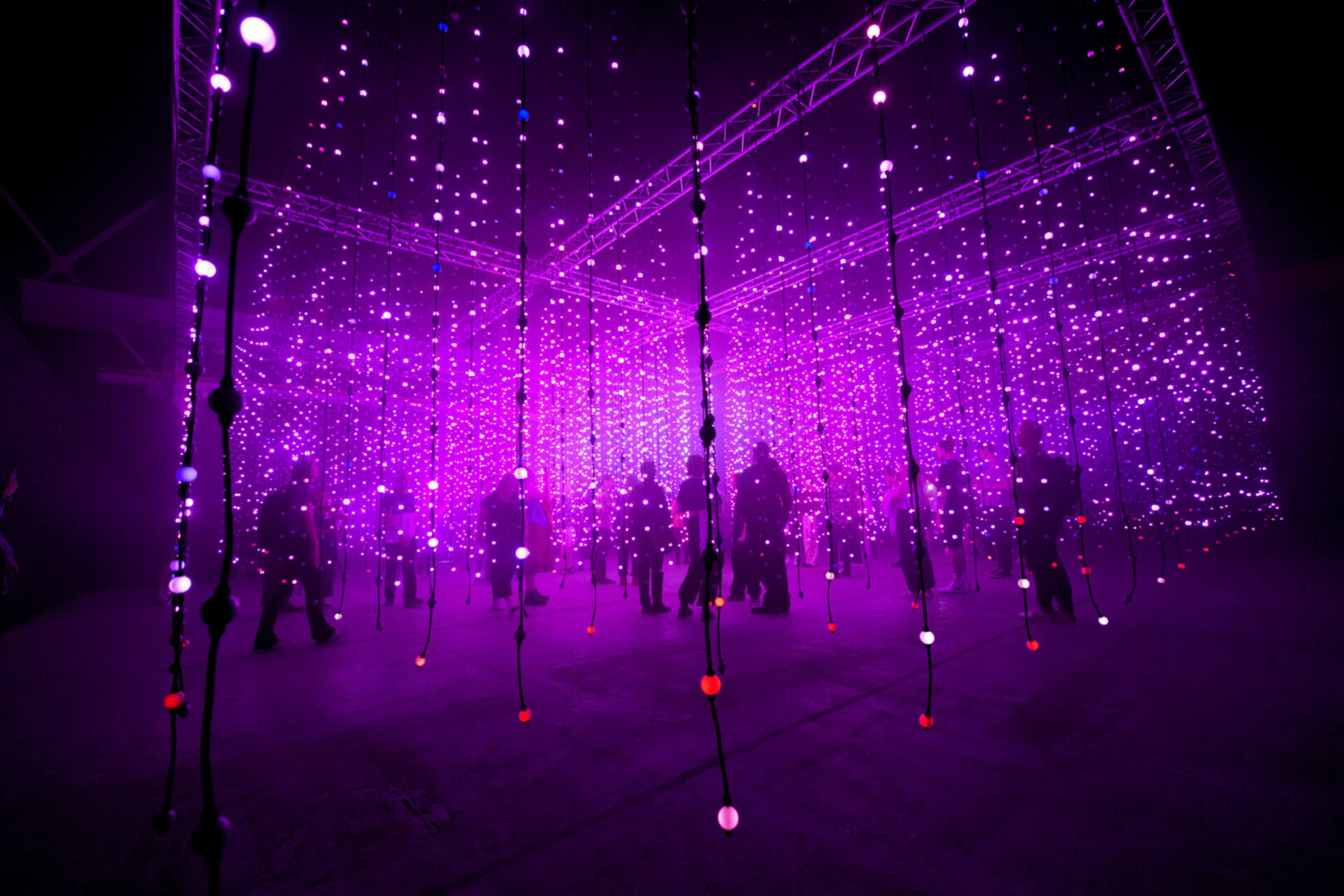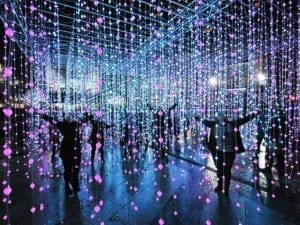Multi-coloured glowing orbs float in between trees. Clusters of light are festooned across cathedrals and castles. Visitors to festivals step inside trailing vines, lit up in slowly shifting shades of green and blue. Squidsoup has been bringing immersive light and sound installations to venues across the world for more than 30 years. Passionate about taking art outside of traditional galleries, their work has been exhibited at Burning Man Festival, Sailsbury and Gloucester Cathedrals and Brooklyn Botanical Gardens. The collective was a finalist in the Aesthetica Art Prize. Now, a 3-storey installation has been revealed in the Heart of Shoreditch, welcoming visitors into an unforgettable journey of light and sound. We spoke to Squidsoup founder Anthony Rowe about Lost in Light and the group’s roots in Shoreditch.

A: Squidsoup is an open group built upon collaboration. Could you tell us a bit about how the artists work together to create an installation?
AR: There are multiple skillsets involved in creating our works – not only artists, but also designers, musicians, programmers and developers, electronics specialists, producers, engineers and so on. Although pretty much everyone in Squidsoup is an artist or at least arts-adjacent, we each come with our own range of aesthetic sensibilities, contributions and visions. All members have a unique contribution to make, and the resultant work is built on that collection of contribution – although not every member of Squidsoup is involved in every project.
A: You’ve been touring your work across the world since 1997, amassing viewers into the millions. What do you think it is about these immersive experiences that has such an enduring appeal?
AR: Light has a universal appeal, fundamental to all life and yet even now its nature is not fully understood. The way we use LED technologies also literally surrounds and envelopes visitors, immersing them in these strange dynamic experiences – physical yet not physical, three-dimensional movement and presence that is still weirdly ephemeral. I hope that the works we make have a broad appeal because they are both immediately enticing, yet also have depths to them, and conceptual rigour, so they can be appreciated at whatever level the visitor wishes. Kids seem to enjoy the viscerality of the works. Finally, I think the flexibility and robustness of the technical systems we’ve developed allow us to present the works to a broad range of audiences in very different circumstances – from art gallery to outdoor winter light festival to live music event.

A: How has the digital art scene changed and developed since you first started working more than 25 years ago?
AR: It’s much larger than it was, and it’s not just us broadening out beyond the highly controlled art gallery. From the Burning Man festival to opera, ideas that began as pure digital artworks have expanded into a million different new spaces. This has come about at least in part because of the availability, decreasing costs and mushrooming abilities of the technologies used by digital artists. And also, of course, the subjects and preoccupations of art and culture generally have moved with a rapidly changing world. Wars, ecocide, populism have replaced Y2K, ozone depletion and other wars. Twenty five years ago, digital art was not regarded as Proper Art by most of the Establishment. It’s still an issue today, but it is indisputable that these new forms of art and experience have become much more accepted. As a result of this, there is now a plethora of highly commercial “immersive experiences” out there – some of which are impressive, but others perhaps not quite so much.
A: You seek to find new audiences and platforms outside of traditional art spaces, like live events and festivals. Why is this important to you?
AR: This may sound pretentious but we really do believe in art for all. We want as many people as possible, from different backgrounds and walks of life, to experience our work and find out what it makes them think and feel. We also enjoy the challenge of putting something up in a completely new situation, working out what works and what doesn’t, and how to use the tools and materials at our disposal most effectively. We learn from each one, and every new event will surprise us in ways we did not expect – from a seminar on darkness in Svalbard (high in the Norwegian Arctic) to a shopping mall in Gloucester.

A: Lost in Light opens in a space that was once a famed destination for London ravers. Did that inform the creation of the exhibition?
AR: It certainly did, in numerous ways. Squidsoup started in Shoreditch in the late 1990s, so we’ve been through at least some of that history and the ever-changing nature of the area. Our first studio was a shared space on Hoxton Square and then we moved to Rivington Street – both places just a stone’s throw away from 118 Curtain Road. Being back in the area for the install has brought the memories flooding back so the Shoreditch vibe has been important to Squidsoup since we began. However, this is an art gallery not a rave! You’re not going to find dance music here (at least during the day), but the sonic pallet does often draw on electronic music, though abstracting, deracinating and separating it from time to create frozen moments of sound and light, abstract flickers of memories, many of which hark back to our early years. The space also retains some of the grungy elements of the squats from back then; graffiti on the walls, cracked concrete floors and so on. It’s more controlled now, but the echoes from the past are still there. And our works are always a conversation with the spaces they are within, drawing from and adding to it. The works are ephemeral, see through things where the light reflects off the walls of each room, revealing new sides to both the works and the architecture of the space.

A: Is there a single installation that you’re most proud of, or that you think defines the collective? Why does this one stand out?
AR: We’re proud of all of them, and I think each has its own unique attributes, and we’ve been surprised by how they play off each other, working together to create an intriguing narrative arc. There are two new works in the exhibition that have not been shown before, and we are particularly pleased with them. Infinite is like a deconstructed string orchestra, frozen in time but exploded in space so that groups of note and light emerge in clusters – in front, behind, by your side, around you. The chord sequence itself, made of individual notes each played through its own speaker – there are over 350 speakers in total – is carefully designed but algorithmically generated, creating an everlasting, longing, sequence. And Three Volumes takes themes and techniques we have previously used in works like Submergence and presents them as individual frames that bleed into and interfere with each other – presented as three suspended objects rather than walkthrough immersive experiences.
A: What would you like people to take away from viewing the installation?
AR: I just hope the works leave a mark, that people come out feeling different to when they went in. The works try to play with our sense of time and space, hopefully people will emerge seeing the world from a slightly different, new, perspective.
Lost in Light opens 25 October at 118 Curtain Road, Shoreditch, London: lostinlight.uk
Words: Emma Jacob and Anthony Rowe
All images courtesy Squidsoup.





